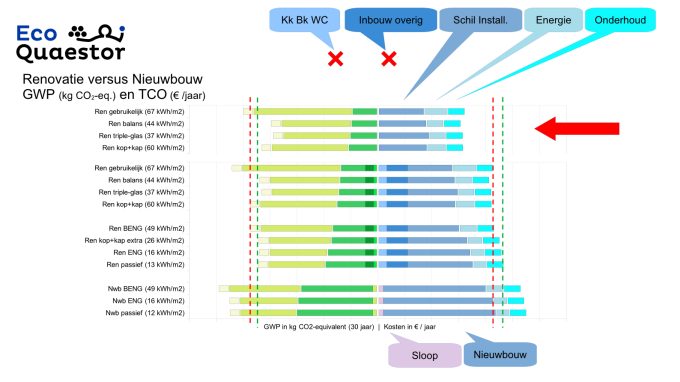
Calculating on the Existing Housing Stock
The study “Calculating on the existing housing stock” uses the EcoQuaestor calculation method, applied to a series of case studies. This method and the underlying database are unique to the Netherlands. They were developed by the cooperative Bouwprojecteconomie, a collaboration between independent construction cost agencies and energy advisors in the Netherlands.
The research compares two main scenarios: ‘preservation-renovation’ and ‘demolition-new construction’. To allow for a fair comparison, the conditions for both scenarios are made as similar as possible. This includes factors like the program of requirements, the calculation of energy consumption during the usage phase, and accounting depreciation. The goal is to enable a ‘fair’ comparison between renovation and new construction in terms of both CO2 impact and financial costs.
The research begins by mapping the development of building quality over time. This quality development is brought together in one model for both new construction and existing buildings. The model is supported by data from CBS on housing construction costs, inflation, and productivity in construction, combined with knowledge about maintenance and renovation. The model shows under what conditions the financial and CO2 impact of new construction and renovation can be compared.
The study takes into account all costs and CO2 emissions, both during the construction phase and in the use phase, providing a complete and fair picture. Within the two main scenarios, numerous variations can be distinguished, such as different levels of renovation, energy requirements, or changing programmatic demands and wishes. Renovation or transformation consistently proves to be more financially advantageous and more climate-friendly than demolition and new construction.
Renovation Saves Costs and Is Better for the Environment
The fact that ‘preservation-renovation’ is not only more sustainable than ‘demolition-new construction’ but also financially more attractive is repeatedly demonstrated when the two scenarios are compared fairly. That is, without the unequal calculation methods often still used in favour of new build. When calculated on a level playing field (as is done here with EcoQuaestor), renovation convincingly outperforms demolition and new build. This is proven by case studies in housing and school construction (which serves here as an example of public buildings). The details vary per case, but the pattern is always the same. The costs for renovation are typically 10-30% lower than for demolition and new construction at the same quality level, and the CO2 footprint is usually 20-50% more favourable. Avoiding demolition and new construction thus does not result in a loss but rather an improvement.
Download our report here.
